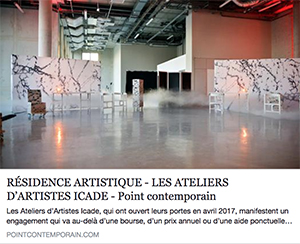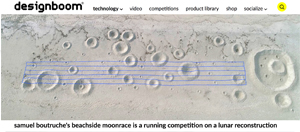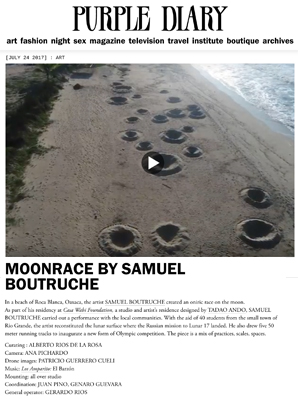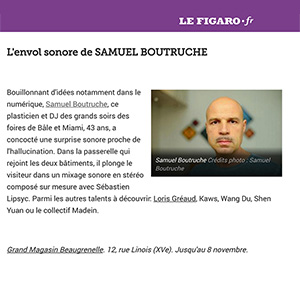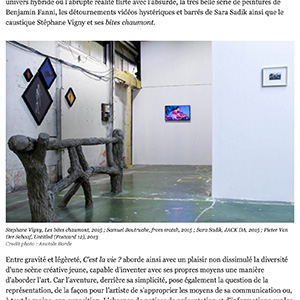Biography
Solo exibitions:
2016
le grand geopolymere (curated by Charlotte Cosson and Emmanuelle Luciani), Mamo, Marseille, France
2015
« piste blanche » (curaté par Marc Olivier Whaler), berge de Seine, Paris
« Folies », Maubeuge, France
« films de vacances » Traffic, Lausane, Suisse. (www.traffic.li)
2013
"Ubik", Mexico city (curated par Anissa Touati)
- Curiosity, Miami
2012
- UCCA, Beijing (curaté par Jérome Sans)
- Luna Park, Miami USA (curaté par Anissa Touati
2011
- OMR Gallery, Mexico
- Monterrey, Mexico
2010
- solo show organized by Galerie Emmanuel Perrotin at Wentrup gallery, Berlin
- «Oeuvres récentes», Galerie Van Der Straeten, Paris
2009
- «La Collection Américaine», Galerie Emmanuel Perrotin booth, Armory Show, NY
- «La Collection Américaine», Galerie Emmanuel Perrotin, Paris
2007
- «Repeat After Me», Musée des Beaux Arts de Mulhouse, France
2006
- Frieze Art Fair, booth of Galerie Emmanuel Perrotin, London, UK
- «La matière du mensonge», Galerie Emmanuel Perrotin, Paris, France
- «Touristes» , Ecole des Beaux Arts, Le Havre , France
2005
- «Touristes», Maison des Arts, Malakoff, France
2002
- «Kolkoz.org», Galerie Emmanuel Perrotin, Paris, France
2000
- Galerie Emmanuel Perrotin, Paris, France
Group exibitions:
2016
- Radical Country (curaté par Nanda Janssen), Dedans Dehors, chateau de La Caze, Casteljaloux, France.
2015
- Spirit your mind (curaté par Anissa Touati, Marie Maerteens, Isabelle Kowal), bar free Spirit, Miami beach.
- « Think Big » (curaté par David Rosenberg), centre Beaugrenelle
- « C’est la vie » (curaté par Neil Beloufa),
- « one night king prédiction » (curaté par Marc Olivier Whaler), chalet society, square de Berlin, Paris
2014
- «Une histoire» Beaubourg, Paris (curaté par Christine Macel)
- «Triangle walks» (curaté par Anissa Touati), Hotel Delano, Miami Beach, USA
2013
- Yodeling circus, Venise, Italy (curaté par Marc Olivier Whaler et Anissa Touati)
- Under the volcano, Nara, Japon (curaté par Anissa Touati)
- Happy Birthday Perrotin, Tri Postal, Lille
- Obs/in, Arles France, (curaté par Yannick Vernet)
- Babylone Baby, Vienne, Austria (curaté par Tjorg Douglas Beer et Anissa Touati)
- Oracular Vernacular, MAMO, Marseille (curaté par Emmanuelle Luciani et Charlotte Cosson)
2012
- «Gold», Blevedere, Vienna, Austria
- «Plaisirs de France», Almaty, Kazakhstan
- «Plaisirs de France», Badu, Azerbaïdjan
2011
- «Paris Première s’expose», Grand Palais, Paris
- «Les Nuits Parisiennes», Villa M, Paris
2010
- Bass Museum of Art, Miami
- «Troisième type», Ecole des Beaux Arts - la Box, Bourges
- «Archichaos», Rove Project, London (curated by Julia Van Hagen)
- «YIA», LA Cartonnerie, Paris
- «Poem Island», Espace Montblanc, Paris
2009
- Collection of FNAC, Musée Château Saint-Jean de Nogent-le-Rotou, France
- «Quand la première ivresse des succès bruyants», Château Guiraud - Sauternes, (Collection of CAPC - Mr. Louis NEGRE)
- «Emoclew» at Parcours Saint Germain, Chapelle des Beaux Art, Paris, France
2007
- «Radiomobile», Basel, Switzerland / Mulhouse, France
- «Playtime», Espace d’art contemporain, réseau régional d’action culturelle, Poitiers, France
- «De leur temps», Musée de Grenoble, France
- «Enlarge Your Practice», [S]extant et plus, Marseilles, France
- «Du machinique et du vivant», La réserve, Pacy sur Eure, France
- «The geopolitics of the animation», Centro Andaluz de Arte Contemporaneo, Séville, Spain
- «Festival des jeux vidéos», Paris, France
- «2007DaejeonFast Mosaic City», Daejeon Museum of Art, Dongchoon-dang, Bohoon-chung, Corea
2006
- «Distortions», Institut d’art contemporain, Villeurbanne, France
- «Version Animée», Centre pour l’image contemporaine, (curator: Laurence Dreyfus), Geneva, Switzerland
- «La force de l’art», Grand Palais, (curator: Olivier Zham), Paris
- «Cinéma d’ameublement», (curators: Julien Taïb and Gilles Alvarès), Espace Paul Ricard, Paris, France
- Scion gallery,(curator: Eva Newton), Los Angeles, USA
- «Re: Re», Espace Paul Ricard, (curator: Jean Marc Chapoulie), Paris, France
- «Notre Histoire», Palais de Tokyo, Paris, France.
2005
- «Limo», (collaboration with David Bertocchi), Galerie la Blanchisserie, Boulogne, France
- «Film de vacances, Hong Kong», Placemaker, Miami, USA
- «Singuliers», Musée d’Art Contemporain de Guangdong, (curators: Thierry Raspail and Thierry Pratt), Canton, China
- «Portraits Arabes», Galerie Emmanuel Perrotin, Paris, France
- Biennale de l’urgence, Groznyï, Chechnya
2004
- «Reactive»,Nationale Gallery, Melbourne, Australia
- «Agrain of dust, a drop of water», Biennale de Gwangju, (curator: Yongwoo Lee),Gwangju, Corea
- «My name is game», Ganat Art center, Seoul, Corea
- «Login», Angers, France
- Galerie Emmanuel Perrotin, Paris, France
- «Vidéos sequences», Maison des Arts, (curator: Aude Cartier), Malakoff, France
2003
- Biennale de Prague/ Digital art video, (curator: Laurence Dreyfus), Prague, Czech Republic
- «Art digital vidéo», (curator: Laurence Dreyfus), Hong Kong, China
2002
- «Double», Whitney Museum, (curator; Miltos Manetas), New York, USA
- «Euro(pe) Campus Art», tour exhibition, Paris, Strasbourg, Toulouse, France
2001
- «Connivence», Biennale d’Art Contemporain de Lyon, (curator: Laurence Dreyfus), Lyon, France
- «Kolkoz.org», FIAC, Galerie Emmanuel Perrotin, Paris, Fance
2000
- Galerie Emmanuel Perrotin, Paris, France
- «L’art au risque du clonage», Centre Culturel, Viry Chatillon, France
1999
- «ZAC 99», Musée d’Art Moderne, (curator: Stéphanie Moisdon and Nicholas Trembley),Paris, France
1998
- «Friction», Galerie Emmanuel Perrotin, Paris, France
1997
- «Bataille d’Austerlitz», FIAC, Galerie Emmanuel Perrotin, Paris, France
- «Espace de Flirt», Fond régional d’art contemporain P.A.C.A, (curator: Eric Mangion),Marseille, France
1996
- M.A.C Attack, Musée d’art Contemporain, Marseille, France
Actions:
2005
- «Lecture, Mélodies du Baron, rires», projection at l’Alcazar, Paris , France
2004
- «Mix», Superdeluxe Club, Tokyo, Japon
2003
- «Il est temps d’aller dormir», Palais de Tokyo, Paris, France
2002
- «Radiomobile», Parc de Bercy, Paris, France
- «Retail vidéo», Fondation Cartier, Paris, (curator: Jean Marc Chapoulie), Paris, France
